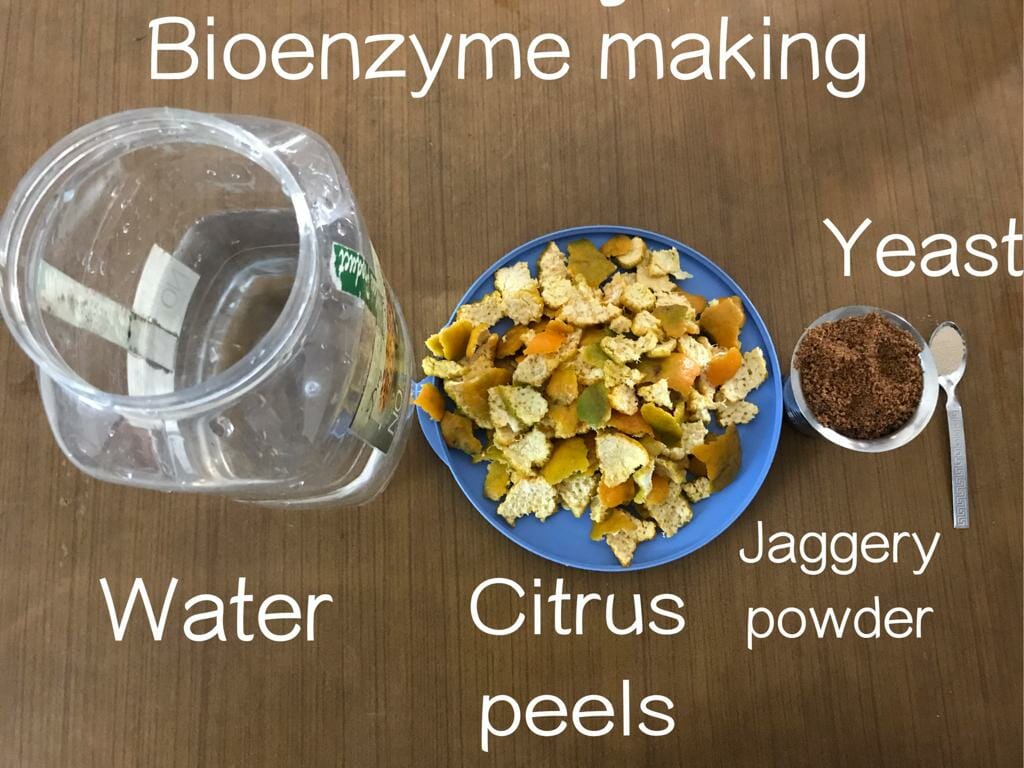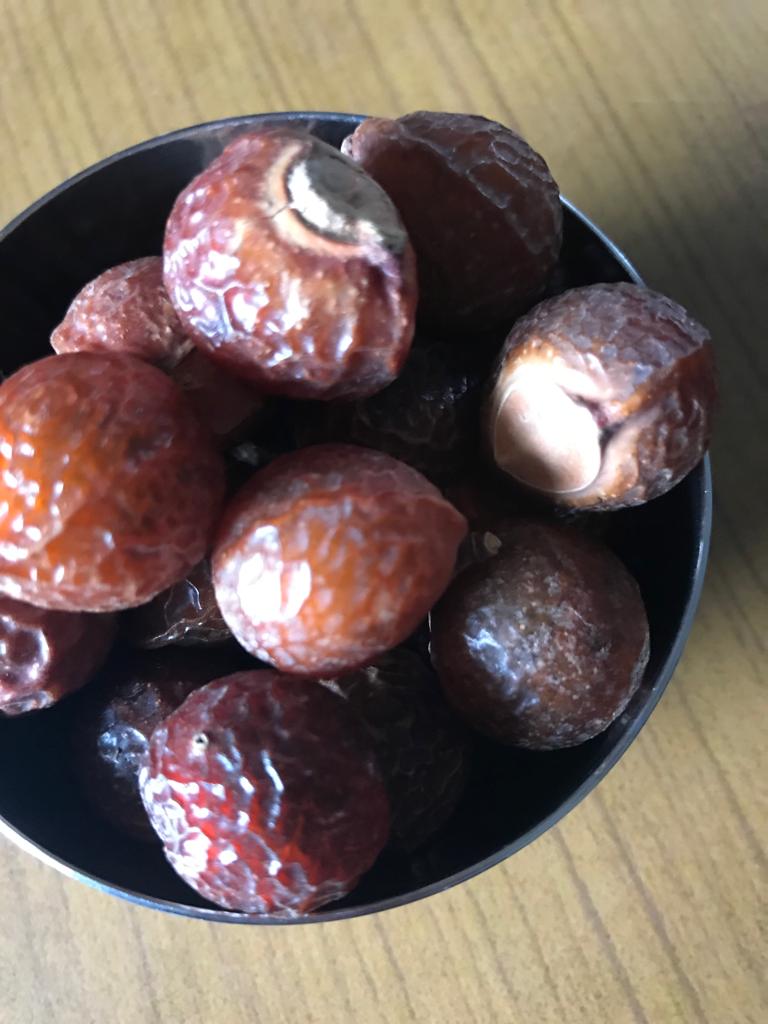“Would this natural cleaner be as effective as the synthetic ones?”
This is a question that dominates the minds of those who consider bio enzyme solutions for cleaning for the first time. The doubt, however, does not last long.
More and more Chennaiites have begun cleaning with bio enzyme cleaners, which are organic solutions made from fruits and vegetables, and can be used to clean surfaces and wash clothes and dishes and also for personal use.
“We have stopped using synthetic chemical solutions to clean now”, says Kalpana Manivannan, an urban farmer who swears by natural cleaners for all household needs.
“It does not cost a dime to make these natural cleaners. They are more effective, friendly to the environment, not hazardous to human health, and to top it all, it is an effective waste management method,” says Kavitha Sivakumar from Medavakkam.
Read more: Home-composting in Chennai: How are people transforming kitchen waste into manure?
What goes into creating bio enzyme cleaners?
“These organic solutions have natural chains of proteins, mineral salts, organic acids, alcohol and enzymes. This solution has the capacity to break down, change, create and catalyse [cleaning reactions]. These are functions that make bio enzyme a wonderful cleaning aid,” says Sathyanarayana N Gummadi, a professor of biotechnology from IIT Madras.
“To make compost, one should avoid adding citric fruit peels. Therefore, making bio enzymes is a great way to make use of them,” says Kalpana.
Bio enzyme enthusiasts from Chennai walk us through the nuts and bolts of making these natural cleaners at home. The solution can be used for personal use and household cleaning purposes.
Only three main ingredients are needed, says Kalpana. One part jaggery, three parts citric peels and 10 parts water.
However, both Kalpana and Kavitha say a big no to white sugar. “White sugar has no carbon content for the bacteria to thrive,” says Kalpana.
One must use plastic containers for making bio enzymes, as they can expand without breaking. “Glass and metal containers are not advisable. Glass may break due to pressure-build up, unlike plastic. Metal may react or get corroded. We do not use metal containers for storing pickles. Similarly, we should not store bio enzymes in metal dabbas,” says Kalpana.
The next most important ingredient is citric peels. “Whenever you eat limes, oranges or lemons, do store them in the freezer. When you get a good amount of peels, you can use them for bio enzymes,” says Kavitha.
“You can even ask juice shops in your neighbourhoods for these peels. They will be more than happy to share them with you,” suggests Kalpana.
DIY method for home use
Kavitha and Kalpana share the steps to make bio enzyme cleaners.
It takes one to three months to make the first batch of cleaning solution.
“People can separate the fruit peels to make different batches of bio enzymes. The enzymes would have a good aroma and effective cleaning action. For instance, enzymes made from sweet lime clean most efficiently,” says Kavitha. But Kalpana puts all of her citrus peels together to make these natural cleaners. “Separating peels to make different batches is laborious if someone is starting out.”
“Tear the peels before adding them to the plastic container,” says Kavitha. After making the enzyme, it will be easy to ground the peels for cleaning up places like kitchen chimneys.
Then, jaggery is added along with water. Now, the fermentation begins, which lets out carbon dioxide. “Among other ingredients, I add a pinch of yeast to expedite the process to one month from three months,” says Kavitha.
The ingredients must not be filled to the brim of the bottle, says Kalpana.
If it is a plastic bottle with a narrow mouth, it is necessary to open and close the bottle daily for the carbon dioxide in the container to escape. “However, if it is a bottle with a large mouth, opening it once in two days would suffice,” says Kavitha. Opening the bottle must be done for around 10 days.
“Every time you open the bottle, stir it with a wooden spoon. Metal ladles can react with the mixture,” says Kavitha.
The container must be stored in a place with no direct sunlight.
Within 30 days (with yeast) or 90 days (without yeast), the bio enzyme cleaner will be ready. If you find all the peels in the bottom of the container, and there is a white layer of mould on the surface, then the solution can be extracted.
The peels lying in the residue can become the starter of the next batch. “Now you can add them along with your fresh fruit peels. The second batch would be ready within a month,” says Kalpana.
One ‘solution’ for many cleaning problems
“Chemical cleaners triggered my skin allergies. Therefore, I started looking for safe alternatives and bio enzyme cleaners did not induce allergies,” says Kavitha. Now she uses these biological substances as detergents, surface and floor cleaners, and dishwashing powders.
“For different cleaning purposes, we have different chemical substances. But bio enzyme cleaners eliminate that need,” says Kalpana.
“This helps us to save money as well,” shares Kavitha.
Kavitha makes a foamy solution for washing clothes with one part of bio enzyme, one part of soap nut shells, which have natural saponins and give rise to foam, and one part water. “We can wash vessels with this solution as well.”
She also uses a pulpy solution to clean greasy areas. “A pulpy solution is obtained after grinding the remaining peels after the clear enzyme is made. It has a bit of abrasiveness to clean tough areas,” says Kavitha.
Besides cleaning, bio enzyme solutions can also be used as air fresheners and hand sanitisers. “Enzymes made of rose flowers can work as a natural air freshener. A bit of essential oil can also be added to it,” says Kavitha.
It can also be mixed with some water and sprayed as a pesticide for plants.
Read more: Chennai air quality: City sees 94% spike in NO2 pollution
Dangers of synthetic chemical cleaners
Many chemical cleaners have volatile organic compounds (VOCs) which can potentially cause cancer. “Volatile organic compounds in cleaning products can affect indoor air quality and add to outdoor smog,” says Sathyanarayana.
Furthermore, chemical cleaners give out residue that cannot be disintegrated further. “For instance, clean your vessels with synthetic dishwashing soaps. Then, run a UV wand over them. You will still find the soap residue sitting on the surface, even after cleaning the vessel multiple times. However, there won’t be any residue while washing with bio enzymes,” says Kavitha.
This chemical soap residue gives rise to non-biodegradable substances, which will pollute the ecosystem and may cause bioaccumulation, says Leslie Lawrence, a Professor of Botany from Madras Christian College. On the other hand, enzymatic cleaners will degrade to form carbon, hydrogen, oxygen and nitrogen, which will go back into the ecosystem, he says.
Bio enzyme cleaners give out biodegradable substances, ensuring a healthy environment which is vital to human health.
The use of bio enzyme cleaners is a win-win solution that prevents pollution of the environment and also safeguards one’s health. It is little wonder that there has been a steady uptick in the number of Chennaiites who have begun making these easy, organic solutions in the comfort of their homes to meet all their cleaning needs.
Errata: In an earlier version, palm sugar had been erroneously mentioned as one of the ingredients in the preparation of bio enzyme cleaners. Only powdered jaggery may be used for the purpose.

